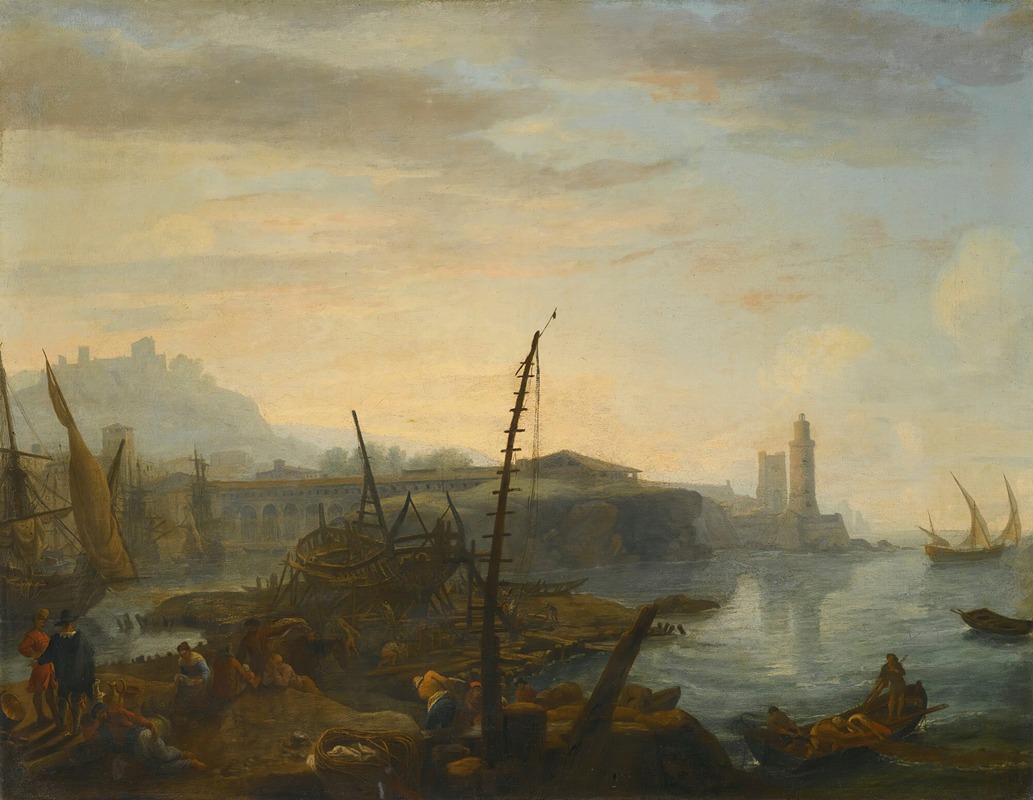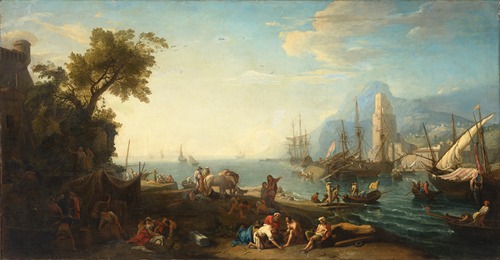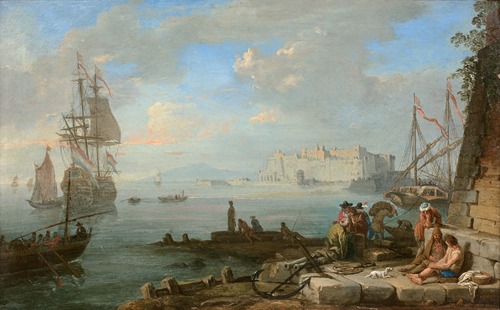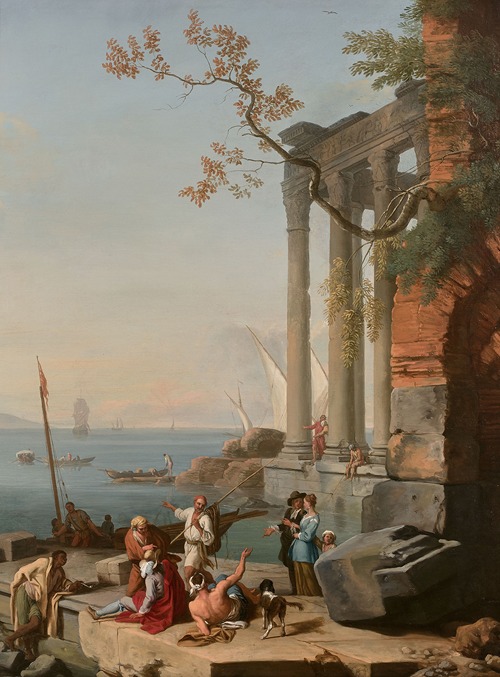
Adrien Manglard was a French painter, draughtsman, and engraver. He was a skilled marine painter, who was able to rapidly advance his career in Rome thanks to his compositional skills, selling paintings to clients such as the Rospigliosi family, Victor Amadeus II, King of Sardinia, and Philip, the Duke of Parma. The latter alone commissioned more than 140 paintings from Manglard.
The son of a modest painter, Manglard was trained in Lyon by his godson Adriaen van der Cabel, a Dutch Golden Age landscapist. In 1734 Manglard was admitted to the Académie Royale de Peinture et de Sculpture, which he entered as a full member in 1736. In his youth he traveled to Rome, where he spent most of his life. He is said to have trained under Bernardino Fergioni (1674–1738) in Italy. Manglard also came into contact with artists in the circle of sculptor Pierre Le Gros the Younger (1666–1719), who commissioned two paintings from him before 1719.
Manglard's best known pupil is arguably Claude-Joseph Vernet, who, upon his arrival in Rome, was welcomed by Manglard into his studio and initiated into seascape painting by him and Fergioni.
Once concentrated in Rome, his work is today spread across private and institutional collections around the world. Manglard is also known for his mural painting. He painted the frescoes of two rooms in the Palazzo Chigi in Rome, including the Sala delle Marine.
Adrien Manglard was born on March 10, 1695 in the city of Lyon, Kingdom of France, the firstborn of Edmond (called Aimé) Manglard and Catherine Rose du Perrier (or Dupérier). He was baptized in the church of Saint-Vincent on March 12 of the same year.
Manglard's father was a modest painter originally from Paris, the son of Jean Manglard, a Parisian bourgeois, and lady Anne Alliot. Manglard's mother was the daughter of Antoine Dupérier, a bookseller and merchant, and Esprite de Tassi. Both Manglard's parents lost their fathers at a young age. Dupérier's mother later remarried to local painter Pierre Savournin, to whom Jean Manglard asked for her hand.
His parents were married on May 21, 1693 in the Basilica of Saint-Martin d'Ainay. Beside Adrien they had two other children, Pierre, born 1700, and Daniel, born in 1702. His family suffered the economic repercussions of the famine caused by the Little Ice Age's extremely cold weather, which led to the seven ill years in Scotland and the remarkably cold Le Grand Hiver in France, with the subsequent famine estimated to have caused 600,000 deaths by the end of 1710 in France. In 1707, Manglard's two brothers Pierre and Daniel were left at the Hôpital de la Charité, a orphanage in Lyon, to which they were admitted as délaissés (abandoned).
Manglard studied under Adriaen van der Cabel in Lyon. Van der Cabel was a Dutch Golden Age landscapist and a pupil of Jan van Goyen who, like Manglard, traveled to Rome in his youth, where he sojourned from 1656 to 1674—his Dutch style coming under the influence of the Romano-Bolognese landscape painting. As a student of van der Cabel, Manglard was influenced by the Dutch Golden age landscape painting, as well as the Italianized Dutch painting style typical of the seventeenth century.
Manglard later moved from Lyon to Marseille, or Avignon, where he studied under the Carthusian painter Joseph Gabriel Imbert (1666–1749), a relatively unknown master of whom today but a few biographical anecdotes and two paintings (a copy of Guido Reni's Annunciazione and a large landscape painting depicting the Flight into Egypt) survive. Manglard learned figure painting with Imbert.
At some point in the 1710s (probably around 1715) Manglard moved to Rome, where he was to spend most of his life and career. While the exact date of Manglard's arrival in Rome is unknown, this certainly took place before 1722. A painting by Manglard dated 1722 (a seascape drawing "touched by strokes of a pen and watercolor, one braccio and 1/6 wide, 15 soldi high, depicting both ships and figures") was once at the Gabburri Gallery in Florence. The painting is now lost. Rome based sculptor Pierre Le Gros acquired six marine views by Manglard. Le Gros died in 1719, which makes these six seascapes the earliest documented paintings by Manglard.
Manglard came to Rome simply as a "tourist"; he wasn't under the protection of the French Academy, which would welcome him as a full member in 1736. In 1722 he was probably already enjoying some degree of fame in Rome. Manglard started to enjoy the patronage of notable commissioners at least since the mid 1720s. In the 1720s he started working for the Corte Sabauda, to which he sent two paintings from Rome in 1726. Manglard's talent as a marine painter "was such that his career advanced rapidly: prestigious clients included Victor Amadeus II, Duke of Savoy and King of Piedmont, who bought two matching pieces from him in 1726 (Turin, Galleria Sabauda), and Philip, Duke of Parma." Philip alone commissioned more than 140 paintings from Manglard to decorate his palaces. Manglard also enjoyed the patronage of the most important Roman families, including the Colonna, the Orsini, the Rondani, the Rospigliosi and the Chigi. For the Chigi he frescoed two rooms on the piano nobile of the Palazzo Chigi, today the official residence of the Prime Minister of Italy.
On June 8, 1728, Catherine Rose du Perrier, Manglard's mother, died in Avignon. Manglard presumably went back to Avignon on this occasion. The same year, his brother Daniel left for Martinique. Three years later, Manglard's father Edmond left France forever.
After a career in Italy which spanned over forty years, Manglard died in Rome on August 1, 1760.
Beside being a painter, Manglard was also an art collector. In January 1761, Rome notary J. L. Vannoi drew up the inventory for Manglard's collection. Manglard's universal successor was his brother Pierre, then resident in Paris.





